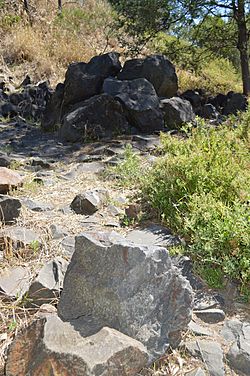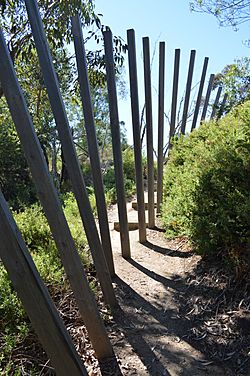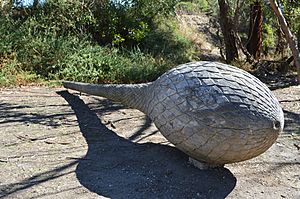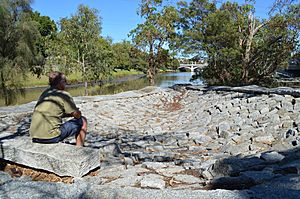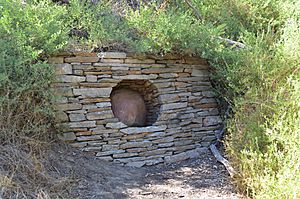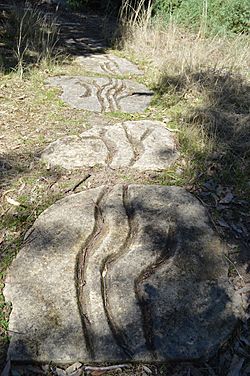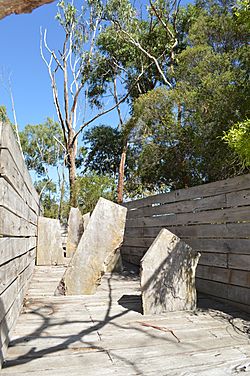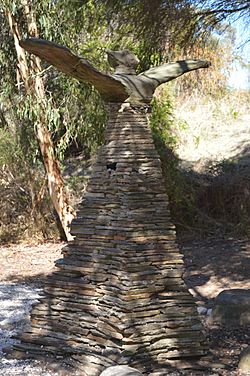Herring Island (Victoria) facts for kids
| Geography | |
|---|---|
| Location | South Yarra, Victoria |
| Coordinates | 37°50′00″S 145°00′11″E / 37.8332°S 145.0031°E |
| Area | 0.032 km2 (0.012 sq mi) |
| Administration | |
| Demographics | |
| Population | 0 |
Herring Island is a small island in Melbourne's Yarra River. It's about 3 kilometres (1.9 mi) from the city centre, near South Yarra. This island is special because it's the only one in the Yarra River! It covers about 3.2 hectares (7.9 acres) (which is like 3.2 football fields).
Herring Island was made by people in 1928. They dug a channel through an old rock quarry. For many years, the Scouts used the island. They named it after Sir Edmund Herring. He was an important person who helped lead the state of Victoria.
Today, Parks Victoria looks after Herring Island. It's a home for native plants and animals, especially birds. It's also a cool place to visit because it's an outdoor sculpture park! You can see artworks by artists like Jill Peck, Ellen Jose, and Andy Goldsworthy.
Contents
Island History: How Herring Island Was Made
Herring Island is not a natural island. It was created in 1928. Workers dug a new path for the Yarra River through an old basalt quarry. This was done to help control floods in the river.
The new island was first called Como Island. It was built up with mud and dirt taken from the river. Walls called "levee banks" were built to protect it. Trees and bushes were planted, but a big flood in November 1934 washed them away.
After the flood, new trees and bushes were planted. The levees were made stronger with more river mud.
Scouts and a New Name
In the 1950s and 1960s, the Scouts leased the island. They renamed it after their president, Sir Edmund Herring. He was a very important judge and also helped lead the state of Victoria.
In 1994, Parks Victoria took over the island. They turned it into a place for wildlife and recreation. A group called the "Friends of Herring Island" has helped Parks Victoria plant native trees and plants again.
Herring Island Today
Herring Island is an important natural and fun place in Melbourne. It has native plants and is a home for local animals. Many birds live there, and insect-eating bats visit at night. Even large fruit bats called grey-headed flying foxes come to find food. These natural areas are special in busy city suburbs.
The old scout hall on the island was fixed up. It is now the Herring Island Gallery.
You can get to the island by a small boat called a punt. The punt leaves from Como Landing. It runs on Saturdays, Sundays, and some public holidays from December to April. You can also visit in your own boat, but you cannot swim in the Yarra River.
Plants and Animals on Herring Island
Herring Island is home to many different plants and animals.
Island Plants
Some of the trees you can see on the island include river red gums, silver wattles, manna gums, and southern mahoganies. You can also find grasses like wallaby grass and spear grass.
Island Animals
Many birds live on the island, such as honeyeaters, willie wagtails, cormorants, kookaburras, magpies, wattlebirds, and white-faced herons. In the water around the island, you might see Pacific black ducks, dusky moorhens, and maned ducks.
The island also has some possums and lizards. At night, tiny micro-bats and larger grey-headed flying foxes visit to find food.
Herring Island Sculpture Park
Herring Island is famous for its outdoor sculpture park. You can walk around and discover many unique artworks.
- Herring Island Environmental Sculpture Park
Audience Sculpture
The sculpture called Audience was made by Julie Collins in 1997. It is created from bluestone, which is a type of rock. This bluestone came from the Domain Tunnel under the Yarra River.
Falling Fence Sculpture
Falling Fence is a sculpture by Melbourne photographer John Gollings and his helper Samantha Slicer. It was put on the island in 2001. It's made from cypress pine wood. The artists designed it to slowly become part of the natural environment over time.
Cairn Sculpture
Cairn was created by British artist Andy Goldsworthy in 1997. It is made from Castlemaine slate, which is a type of rock. You can find this sculpture in the only valley on the island.
- Herring Island Environmental Sculpture Park
Scaled Stem Sculpture
Scaled Stem was made by Melbourne artist Robert Bridgewater in 1999. He carved it from a type of wood called Cupressus macrocarpa. Robert Bridgewater says his art explores how shapes, patterns, and materials connect.
Steerage Sculpture
Steerage was created by Canberra artist Jill Peck in 1997. It is made from Harcourt granite, a very hard rock. The sculpture is shaped like a boat and points towards the city.
Stone House Sculpture
Stone House is another sculpture by Andy Goldsworthy, made in 1997. This artwork is built from Dunkeld sandstone.
- Herring Island Environmental Sculpture Park
-
Tanderrum (1997) by Ellen Jose
A Hill, a River, Two Rocks and a Presence Sculpture
A Hill, a River, Two Rocks and a Presence is an artwork by Melbourne artist John Davis. It uses wood and stone. It was first made with tree branches, but these got damaged. They were replaced with limestone.
Ramp Sculpture
Ramp is a sculpture made from red gum wood by Victorian artist Robert Jacks.
Tanderrum Sculpture
Tanderrum was created by Torres Strait Islander artist Ellen Jose in 1997. It is made from Mt William greenstone, Castlemaine slate, and redbox wood. This artwork represents the spirit of the Kulin people. They are the traditional owners of the land where Melbourne is now. This artwork was updated in 2008.
Images for kids




